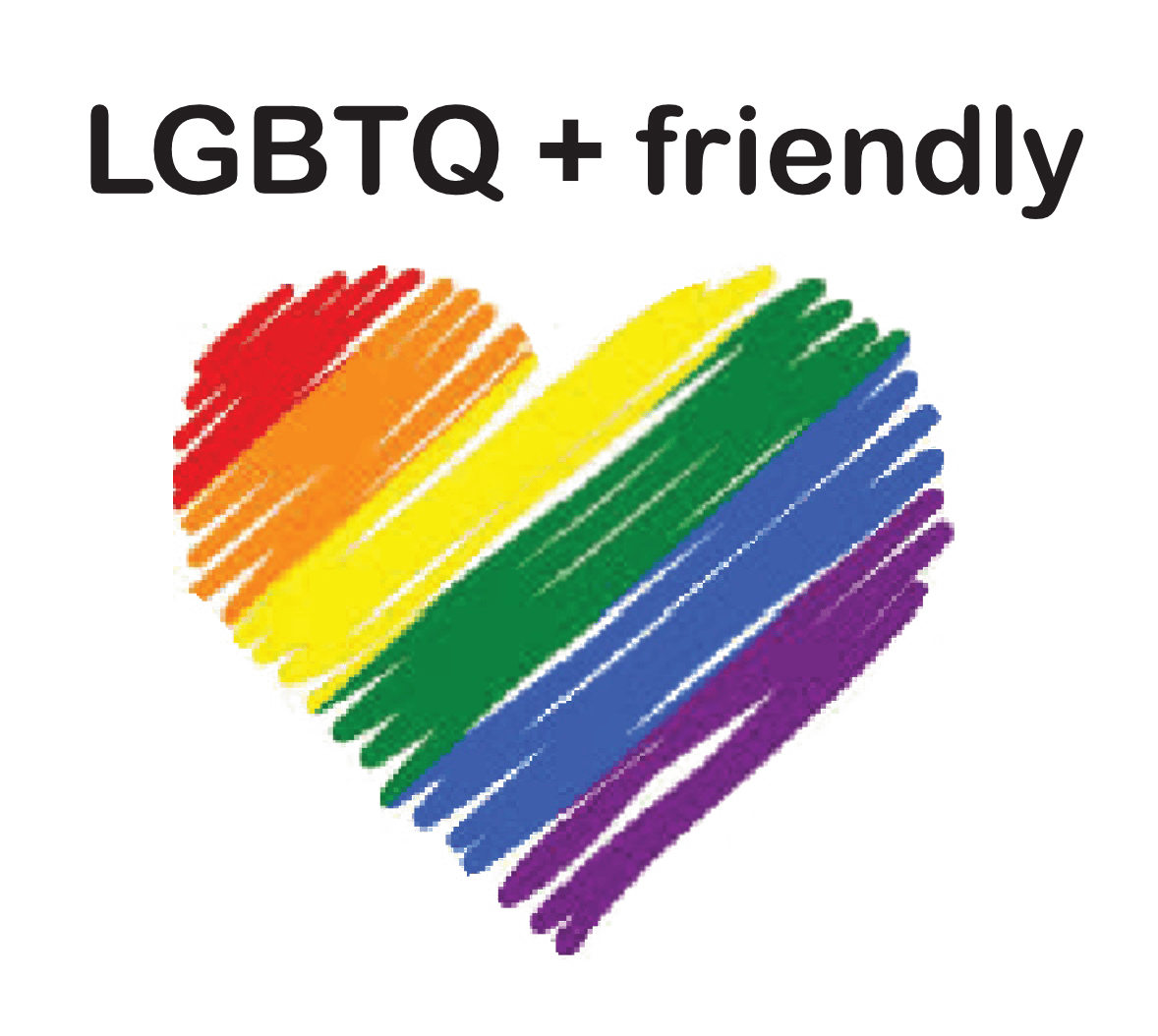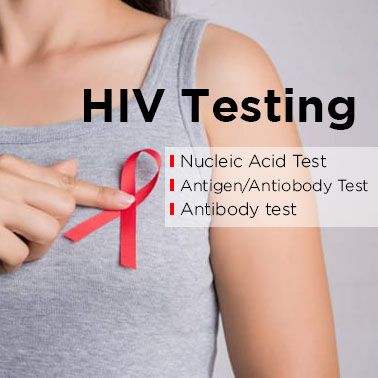
HIV Testing in Hong Kong: Window Period, Importance, Accuracy, and Cost
Understanding HIV testing is a crucial step in protecting your health and that of your partners. In Hong Kong, there are various testing options available, ranging from self-testing kits to HIV RNA test. This article provides detailed information on the importance of HIV testing, types of tests, window periods, accuracy and pricing in Hong Kong to help you make an informed decision.
Why is HIV Testing Important?
Getting tested for HIV to understand your infection status offers significant benefits for both you and your partner.
- For Yourself: Early detection means early treatment. Diagnosing the infection in its early stages allows for prompt initiation of antiretroviral therapy (ART), preventing severe damage to the immune system, effectively stopping the progression to AIDS, and preventing complications. Lifelong ART can greatly improve health outcomes and survival rates.
- For Your Partner: When an infected person receives treatment and achieves a sustained undetectable viral load (U=U, Undetectable = Untransmittable), HIV cannot be transmitted through sexual contact, thereby protecting their partner.
Types of HIV Tests and the Window Period
The "window period" for an HIV test refers to the time between when a person is infected with the virus and when the test can reliably detect a positive result. During the window period, even if the test result is negative, an infected individual may still be highly contagious. The following table compares the window periods for different testing technologies:
| HIV Test Type | Approximate Window Period |
|---|---|
| First Generation | Shortest ~5 weeks |
| Second Generation | Reduced to shortest ~4 weeks |
| Third Generation | Reduced to shortest ~3 weeks |
| Fourth Generation(Laboratory Test) | Reduced to shortest ~2 weeks |
Who should get tested for HIV?
Everyone who is sexually active should get tested for HIV at least once to ascertain their HIV status. However, people at higher risk of HIV infection (high risk groups) should consider getting tested more frequently, including:
- Gay men or men who have sex with men (MSM)
- Those who had sex with an HIV-positive partner
- Those who had new sexual partner(s) since their last HIV test
- Intravenous drug users, or shared injection equipment with others
- Sex workers
- Clients of sex workers
- Those who were diagnosed with a sexually transmitted disease (STD)
- Those who had sex with a partner with one or more risk factors listed above
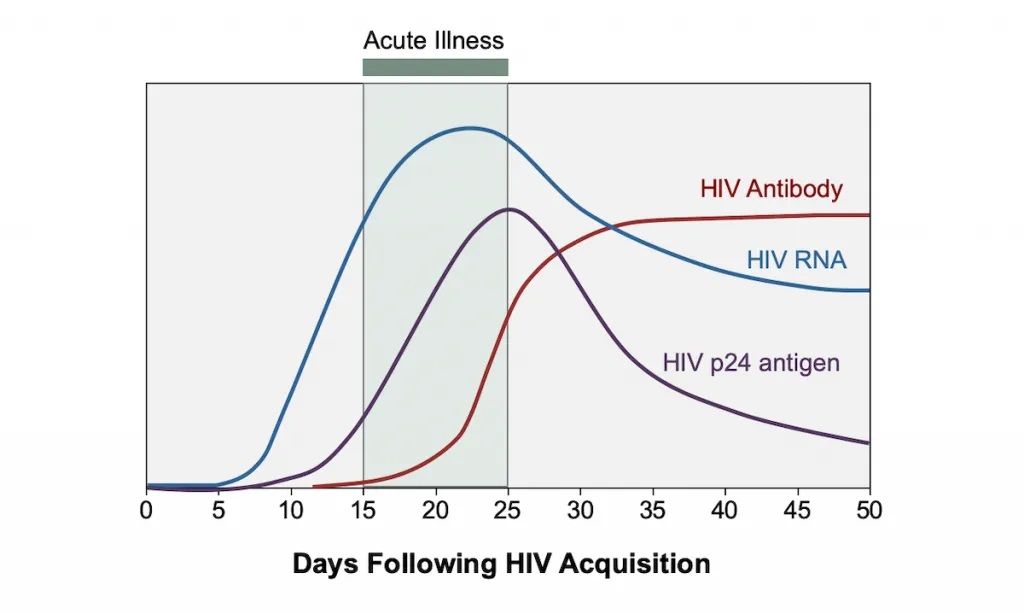
Common HIV Testing Methods
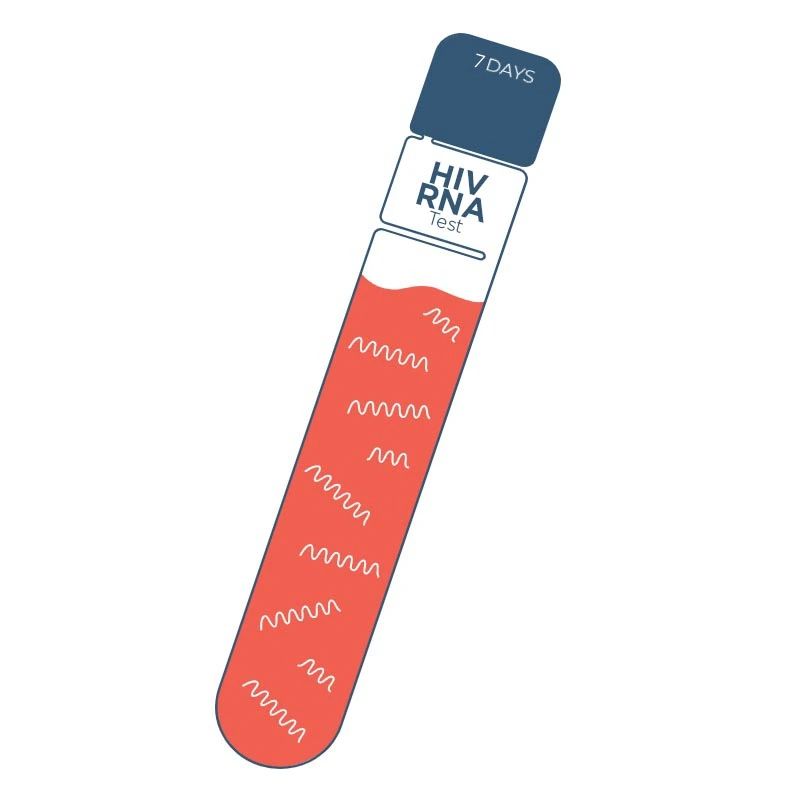
1. HIV RNA Test (Nucleic Acid Test - NAT):
- Principle: Detects the genetic material (RNA) of the HIV virus in the blood. Highly sensitive.
- Window Period: Approximately 7 days.
- Result Time: 4-16 hours.
- Price: Around HK$1,450.
- Characteristics: Can detect infection earliest, but not typically recommended for standalone diagnosis; usually used in conjunction with other tests.
2. Fourth Generation HIV p24 Antigen/Antibody Test (Combo Test):
- Principle: Simultaneously detects the p24 viral antigen an
- d HIV-1 & HIV-2 antibodies (IgG and IgM).
- Window Period: Approximately 14 days.
- Result Time: 8-24 hours.
- Price: Around HK$390.
- Laboratory Test is used.
- Characteristics: Currently the gold standard for diagnosing HIV infection; can detect both acute and chronic infections.
3. HIV Antibody Rapid Test:
- Principle: Detects HIV antibodies in blood or oral fluid.
- Window Period: 23 to 90 days (recommended to test at 90 days to rule out infection).
- Result Time: About 15 minutes.
- Price: Around HK$320.
- Not a Laboratory test.
- Characteristics: Convenient and fast, but used for screening only; positive results require further confirmation.
HIV Tests for Early detection
Recent advancement in diagnostic technology have provided newer generations of HIV testing to be performed at higher accuracy with shorter window period. Rapid and reliable diagnosis of HIV infection not only allows the use of anti-retroviral therapy (ART) to be initiated as early as possible, but also plays a crucial role in preventing transmission to others.
(REF: Hurt, C. B., Nelson, J. A., Hightow-Weidman, L. B., & Miller, W. C. (2017). Selecting an HIV test: a narrative review for clinicians and researchers. Sexually transmitted diseases, 44(12), 739.).
There are 3 types of HIV test available:
HIV RNA test
which that detects the the actual number of HIV in the blood. It is also known as is the HIV nucleic acid amplification test (NAAT), or the HIV viral load test. The HIV RNA test is the most sensitive test among all available HIV tests. It can detect the presence and quantity of HIV RNA in venous blood, which is mainly used:
- To confirm suspected HIV infection
- To monitor the viral load for HIV-positive people
- To detect early HIV infection
Our HIV RNA detection system is an enclosed, fully automatic system and result is available within a few hours. The earliest detection of HIV RNA is about one week post exposure Research suggested that an HIV RNA test with a sensitively of 50 copies/ml would detect HIV infection approximately 7 days before a p24 antigen/antibody test (window period of 14 days). There is currently no research evidence to support the use of HIV RNA test less than 7 days post exposure.
Window period of HIV RNA Test:
7 days after exposure
(REF: Stekler J, et. Al., Screening for acute HIV infection: lessons learned. Clinical Infectious Diseases. 2007).
(REF: Fiebig EW, et. Al. Dynamics of HIV viremia and antibody seroconversion in plasma donors: implications for diagnosis and staging of primary HIV infection. AIDS . 2003. 17:1871–1879.)
The HIV RNA Test is not recommended for diagnostic purposes. Some laboratories that perform pooled sample for HIV RNA test with the dilution of samples may result in false-negative test with early HIV infection. Therefore, the result of the 4th generation HIV (p24 combo) test should be used to determine infection status, especially cases with low HIV RNA level.
(REF: Busch MP, et al. Relative sensitivities of licensed nucleic acid amplification tests for detection of viremia in early human immunodeficiency virus and hepatitis C virus infection. Transfusion 2005; 45:1853–63.)
The HIV RNA test is expensive but it has a shortest window period and allows detection of very early HIV infection. You may consider having an HIV RNA test if you had a high-risk exposure, or showing early symptoms of HIV infection after a possible exposure. o An HIV RNA test should not be used to test for HIV infection if you are currently using or recently used post-exposure prophylaxis (PEP), as the medication is known to suppress viral replication which could lead to a false-negative result.
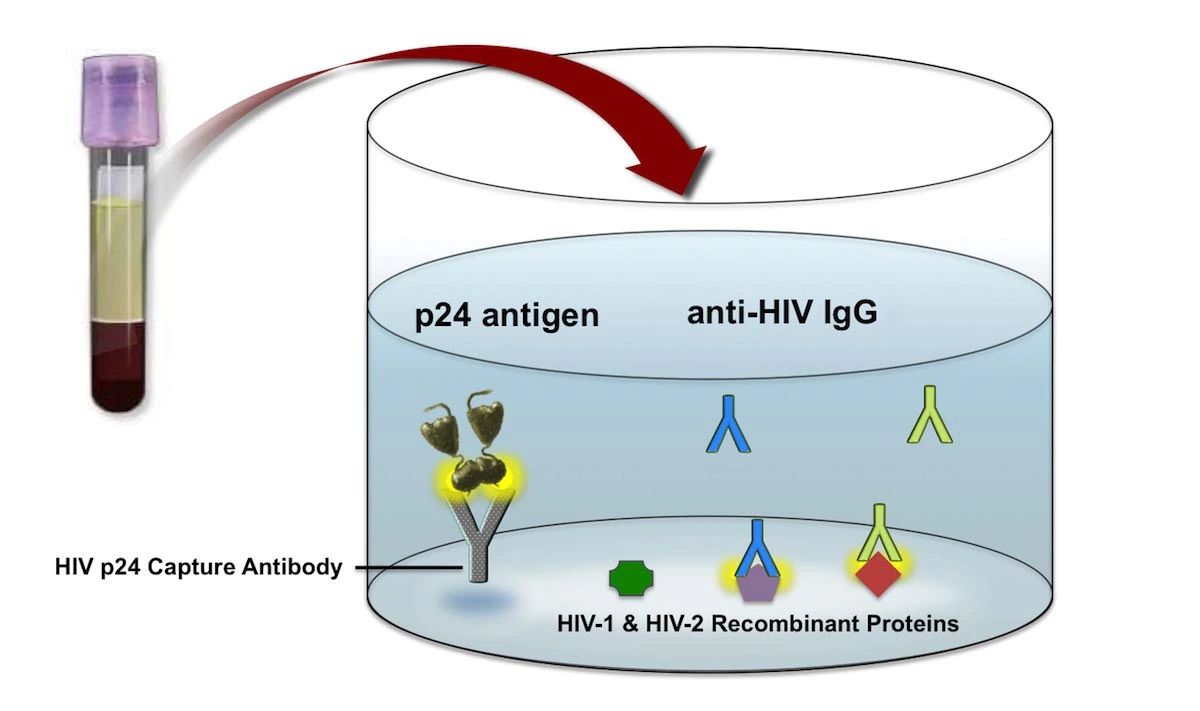
HIV p24 antigen/antibody combo test
which simultaneously detects the viral protein p24, as well as antibodies (both IgM and IgG) to HIV-1 (including group O) and HIV-2. When the test detects HIV p24 antigen (which appears earlier) or/and HIV antibodies (which appears later), it is considered a positive result. The duo detection ability (antigen/antibody) allows the test to identify early acute and chronic HIV-1 and HIV-2 infection, during or after seroconversion and is currently the gold standard for the diagnosis of acute and chronic HIV infections. The 4th generation HIV p24 antigen/antibody test has a reported average window period of 14 - 21 days, which may vary upon different individuals’ immune response.
Fourth-generation laboratory tests reliably exclude HIV by 45 days post-exposure, and this should be the window period applied when utilising these tests. [BHIVA/BASHH/BIA Adult HIV Testing Guidelines 2020]
| HIV tests | Window Period | |
| 1st generation | → | Minimum about 5 weeks |
| 2nd generation | → | Reduced to a minimum of 4 weeks (28 days) |
| 3rd generation | → | Reduced to a minimum of 3 weeks (21 days) |
| 4th generation(Lab test) | → | Reduced to a minimum of 2 weeks (14 days) |
Window Period of HIV p24 combo Test:
14 days after exposure
(Ref: Paul R. Wratil et. Al. 2020 Comparative multi-assay evaluation of Determine™ HIV-1/2 Ag/Ab Combo rapid diagnostic tests in acute and chronic HIV infection. Med Microbiol Immunol. 2020; 209(2): 139–150.).
(Ref: Darlene Taylor et. Al. (2014) Probability of a false-negative HIV antibody test result during the window period: a tool for pre- and post-test counselling. Int J STD AIDS. 2015 Mar;26(4):215-24.)

Rapid HIV antibody test (quick test)
which only detects HIV antibodies in blood or oral fluid (not saliva) and can take 23 to 90 days to detect HIV infection after a possible exposure. Both the 2nd generation rapid HIV test (detects IgG antibody) and the 3rd generation rapid HIV antibody tests (detects both IgM and IgG antibody) are commonly used. Research shows that 99% of individuals infected with HIV would have detectable antibody level from blood at 57 days post exposure and 100% of HIV-infected individuals would have detectable antibody level from finger prick blood at 90 days after exposure.
Window period of HIV Quick Test:
90 days after exposure
(REF: Kevin P. Delaney et al. (2017) Time Until Emergence of HIV Test Reactivity Following Infection With HIV-1: Implications for Interpreting Test Results and Retesting After Exposure Clinical Infectious Diseases, Volume 64, Issue 1, 1 January 2017, Pages 53–59)
(Ref. Delaney KP et al. Time from HIV infection to earliest detection for 4 FDA-approved point-of-care tests. Conference on Retroviruses and Opportunistic Infections, abstract 565, 2018.)
Our rapid test provided is approved by the WHO pre-qualification programme, which means it reaches the unified standards of quality, safety and efficacy for HIV/AIDS, which indicates the product of consistent quality in accordance with international standards and WHO/UNFPA specifications.
The rapid HIV antibody test is used for screening purpose only. If the rapid test result is positive, a follow-up confirmatory test (using venous blood and performed in a laboratory) should be performed to confirmed HIV infection.
Testing Schedule for ruling out HIV infection
The composite HIV test can completely rule out HIV infection in the shortest time. It requires a simultaneous HIV RNA test and HIV p24 antigen and antibody test (HIV p24 combo test) within a window period of 28 days or more. If the test results are both negative, HIV infection can be 100% ruled out.
| Composite HIV Test (Lab Test) | Window Period (100% rule out) | Price |
| HIV RNA Test + HIV p24 Antigen & Antibody test | 28 days or above | $1840 |
HIV Test List for HIV Detection
Our centre provide fast results, NOT WITH DAYS.
- Ultrasensitive Extended Coverage HIV RNA PCR (Quantitative) - 4-16 hours* turnaround time
- HIV p24 Antigen & Antibody Combo Test - 4-16 hours* turnaround time
- HIV Quick Test - 15 minutes
*Test should be completed at or before 4pm.
| Test Items | Price |
| HIV p24 Antigen Antibody Combo Test | $390 |
| Ultrasensitive Extended Coverage HIV RNA PCR (Quantitative) | $1,450 |
| HIV Quick Test* | $320 |
*HIV quick tests do not provide a test report.
How to deal with HIV Result
A negative HIV result. This means that you are not infected with HIV. You may consider taking preventive measures to reduce your risk of HIV infection, such as practice safe sex, use condoms or pre-exposure prophylaxis (PrEP).
A positive HIV result. If the result of your confirmatory HIV test is positive, that means you have HIV (HIV positive). You should consult a doctor and get started on anti-retroviral therapy (ART) as soon as possible.
Although there is no cure for HIV, ART can suppress viral replication, protect your immune system and stop HIV from progressing to AIDS. You should regularly monitor your viral load (amount of HIV) and CD4+ cell count (reflects the state of your immune system) regularly to make sure your medication is working effectively.
If you take ART as prescribed and maintain an undetectable viral load, you can stay healthy for years and will not transmit HIV to others even during unprotected sex (undetectable = untransmittable).
(Text Only)

